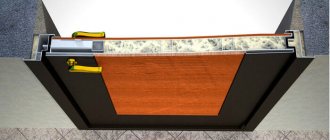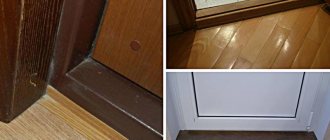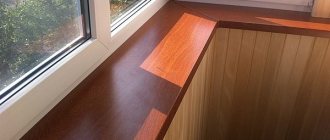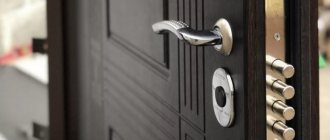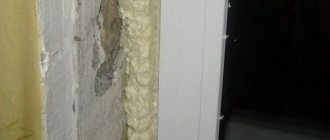A doorway without a door allows you to visually expand the space, adjust its visual sensitivity, combine several rooms into a single zone, and give the interior lightness and freedom with conventionally defined boundaries. To make such an opening look complete, it will require finishing with various materials. How to decorate an open doorway - read our article with photo examples.
Materials
“In large rooms, the decor of a doorway in the form of an arched arc lying on pilasters attached to the sides of the entrance will look great.”
What is the main thing in modern doorway decor? Get away from the “door-frame” stereotype. It remains only to figure out how best to do this.
Plastic panels This material can be an excellent finish for a doorway if it imitates a wooden structure. The main thing is to choose it exactly in the color of the door leaf. This solution will look quite stylish. Strict lines will contrast with the decoration of the walls, and you will get the impression that the ceiling in the room has become slightly higher and the doorway slightly wider. If you look at panel finishing from a practical point of view, there will be solid advantages here too. There are absolutely no traces of touch left on the surface of the material. The process of decorating a doorway with panels is also simple. To do this, you need to clean the surface of the wall and use liquid nails.
Wood-look plastic panels in doorway trim
Decorative stone This material is considered one of the most successful for finishing an area such as a doorway. The pleasure, of course, is not cheap, and in terms of work it is labor-intensive, but the result is worth it, because stone is not only durable, practical and durable, but also incredibly beautiful. Small stones are usually selected for finishing work. Stone edging around the perimeter of the door opening can be laid smoothly by cutting off excess parts of the elements and laying them out along the outlined lines, but designers like a more original option with “ragged” edges. In this option, the stone is not processed additionally, but is laid in random order. The color scheme of the decoration is matched to the general background of the room. The pebbles are attached using regular tile adhesive, but to ensure that there are no problems with the masonry and that individual components do not fall out of it, attention must be paid to preparing the surface to be finished. It is thoroughly cleaned of dirt and treated several times with a special composition of primer.
Decorating a doorway with artificial stone
Polyurethane stucco The location of the doors will tell you how to properly decorate a doorway with polyurethane stucco. This type of finish is very similar to gypsum analogues, however, only in appearance. In terms of weight, polyurethane is much lighter, so it sticks to any surface without any problems. When working with such a finish, you need to pay attention to its relief and here’s why. Provided that the doors to be finished are located in a small hallway or narrow corridor, it is necessary to select flatter parts for their design. In this case, the space will not be overloaded, and you will not cling to protruding parts when entering or exiting through the opening.
Laconic stucco elements for finishing narrow doorways
In large rooms, the decor of the doorway in the form of an arched arc lying on pilasters attached to the sides of the entrance will look great. Designers like to work with polyurethane elements because they initially have a snow-white color and can easily be given any desired shade.
Opening decor in the form of an arched arc
Clinker Another finishing material for a doorway is clinker. “Brick” tiles have appeared in the arsenal of designers a long time ago. It was used to decorate cottage facades. Today, clinker is increasingly appearing in interior decoration. They lay out the areas of doors and windows. How to decorate a doorway with clinker? It is best to follow the principle of masonry, that is, “in a running start.” This solution looks impressive and does not require clear drawing of lines, which means that the work can be done independently, without involving professionals and without incurring extra costs.
Clinker in the design of a doorway
Textiles This material best hides minor imperfections in the design of door openings and gives it a stylish look. The doorway can be hidden:
1. Behind curtains and curtains.
Their length will depend on the decor style of the room. Classic window options with side hangers are perfect for these purposes. In the decoration of the doorway, curtains can be used not only with textile textures, but also with items made of beads, wood, clay, shells, dried fruits, bamboo, and candies. In general, you can create them from any available materials and the more unusual they are, the better the result will be.
Textile decoration of the doorway
2. Behind the lambrequins.
They also give an opening without a door an original look and simply complement the curtains perfectly.
Lambrequins give an opening without a door an original look
3. Behind the blinds.
Their appearance in the doorway has not only a decorative purpose. Blinds are often involved in the zoning process, entrusting them with the mission of delimiting space. Curtains of this type are easy to manage. They lower and open at the right moment without any problems. This method of decorating a doorway using blinds can be interpreted not as space decor, but as an interior partition. This solution will be successful both in homes and in the office. The blinds themselves can be veneered, sliding, mobile, or glass. Japanese-style rope blinds add special chic to the decor.
Textile blinds in the decor of a doorway
Design methods
To choose the right solution for a doorway, first think about its shape. The front door is traditionally associated with a rectangle. In the absence of doors, interior rooms are given shaped configurations.
Classic
Classic style technology allows you to refine the passage between rooms without affecting its shape. A traditional rectangle, with or without a sash, is lined with platbands. Extensions are used to finish wide slopes. You can glue a decorative corner as platbands. The stained glass windows above the doorway, made from multi-colored glass inserts, look beautiful.
Arch
The arched shape is considered the most popular way to decorate an opening without a sash. Its advantage lies in smoothing out sharp corners. Smooth transitions of the upper part of the door structure allow you to play with your imagination. In low rooms, the arch visually makes the ceiling higher, and in high rooms - lower. The effect is achieved due to the size of the structure. The more the arch expands, the lower the ceiling appears.
The wood frame of the arched doorway between the rooms looks rich. In a budget option, you can use plastic or MDF. Arches usually separate a hall from a kitchen or hallway, and are also used when combining an insulated loggia with a living room.
Trapezoid
Not a very popular form for decorating a passage in a partition, especially in a small apartment. Sharp corners will make the room uncomfortable. The trapezoid is suitable for a wide doorway in a large apartment, and the best cladding option is materials of light and warm shades. In a house with low ceilings, it is undesirable to make the upper part of the trapezoid narrow. A small jumper will visually lower the ceiling, make the room smaller and give the interior a heavy look.
Asymmetrical shape
To achieve a modern interior, room design is often associated with the idea of arranging an asymmetrical opening on the interior partition. Construction stores offer ready-made kits. When implementing your idea, a fancy shape is created with a galvanized profile and covered with plasterboard on top.
An asymmetrical configuration involves the formation of smooth transitions in different parts of the structure. It is better to avoid sharp corners. Finishing is usually done by painting or wallpapering.
Decoration with curtains
Free passage between rooms without a door is decorated with a screen or curtains. This is the most affordable way to decorate. Fabric curtains look cozy. Thread curtains create an unusual interior. In the “eco” style, the room is decorated with bamboo curtains.
Doorway decor: design ideas
Standard design The method of finishing an opening with the letter “P” remains simple, unpretentious, but at the same time laconic and elegant. In this case, the door leaf is removed, the frame is removed, and the resulting space is decorated using any of the above methods:
1. Clinker. 2. Polyurethane stucco. 3. Stone. 4. Plastic panels.
Finishing the opening with the letter “P”
Arched design If you look at it from a design point of view, an arched doorway looks the most impressive. Such solutions are very successful when organizing passages in narrow corridors and tiny hallways. With their help, it is possible to correct the spatial perception of these rooms and make the atmosphere in them more airy.
Arched design is ideal for narrow openings
The main thing is to decide exactly how to design the arched arc of the doorway.
Designers advise: – For rooms with low ceiling heights, use arches with a corner radius larger than half the width of the opening being designed. In this case, the arc will turn out to be gentle, and the formed passage will appear wider, which in combination will slightly visually lift the overhanging ceiling.
Gentle arched design for rooms with low ceilings
– In the version with a classic arch, maintain the radius of the arc in a size directly proportional to half of the opening. Arches of this type traditionally decorate rooms with high ceiling heights.
Arched opening for spacious rooms
– Do not get hung up on standard visions of arched structures and decorate the doorway with arches not only of straight, classic and round shapes, but also in the form of an ellipse, trapezoid or, in general, asymmetry shifted to one side.
Arched doorway of original shape
You can select arches for the interior according to stylistic characteristics and decorate them in accordance with the traditions of the direction. Thus, arches in Art Nouveau are distinguished by an arc with a rise. In the classics, the arched arc has the correct radius. In romanticism, the place above the opening bears little resemblance to an arc. Only the corners of the transition to the transverse supports are rounded here. An ellipsoidal arc and other extraordinary solutions are the prerogative of modern minimalist interiors.
Doorway in oriental style
Advantages
Doorways without a door have the following advantages:
- Saving space due to the lack of free space along the opening path of the door leaf. For normal operation of a swing door, a minimum of 1 m2 of space is required, which should be left free, without cluttering it with furniture and other interior items;
- More light, this is especially true for adjacent rooms, one of which does not have a window or is equipped with a small window. An open doorway will allow natural light to enter a dark room;
- Air circulation, relevant for small rooms with insufficient ventilation, for example, due to the lack of a window;
- Combining space through two rooms, decorated in the same style, between which there will be a conventional demarcation in the form of an open opening;
- Visual expansion of space by connecting small rooms to the main one, for example, a balcony or loggia to a room;
- Zoning. A similar effect is used when dividing one large room into two smaller ones, while maintaining the freedom and lightness of the space due to the open door portal;
- Easy to maintain, as there is no need to regularly wipe the sashes, the glass inside them, or lubricate the locks and hinges;
- In addition, a stylishly designed doorway without a door allows you to give the room an original and unique look due to its shape, texture or shade.
How to decorate a doorway as an accent option
“Choose stucco molding of such a shape that the decor of the doorway, echoing the overall decor, at the same time fascinates with its beauty”
Since we have already taken up the issue of decorating doorways, we need to consider ideas that can turn a banal arch into the center of an interior composition. And this is quite logical. Openings in this form are most often arranged solely for the purpose of diverting attention from the unprepossessing appearance of the premises in which they are located. This is a delicate matter, full of cunning tricks, however, knowing the nuances, you can easily cope with the task.
Accent doorway option
The easiest way to achieve the desired result is to use stucco in decoration. Attaching polyurethane elements is not difficult. Liquid nails and any other special glue can serve as fasteners. Look for quality material. Choose stucco molding of such a shape that the decor of the doorway, echoing the overall decor, will at the same time fascinate with its beauty.
Stucco as an accent in the design of a doorway
If possible, be sure to use moldings to decorate doors. These overlay panels can be easily selected in color and configuration. In addition to them, you can use sandriks. They will be simply indispensable in attracting attention to the arched structure. They are something like a pediment, only slightly raised at the top. The appearance of imitations of columns at the entrance is also considered common practice.
Columns in the design of doorways
What else will be perceived as original in the decoration of the entrance to a room with a missing door leaf is a mosaic. This decor looks really stylish, and besides, the solution is not hackneyed and has a claim to uniqueness, because it allows you to decorate the surface in a version developed by you, impressive with the beauty of the design, and not in the standard vision.
Finishing a doorway with mosaics
How to decorate an empty doorway so that it attracts with its unusualness? Try solid wood panels. When creating an arched arc, they can be laid out not only in a horizontal plane, but also mounted vertically. This also gives a certain scope for imagination. You can play with the tonal tints of the material or the difference in its sizes. Precious species in the decoration of the arch will bring chic to the entire setting.
The doorway is decorated with solid wood
In the apartments of the old building there is not much room to roam. The problem of saving space is acute here. Arch can also be involved in solving it. Line its opening with facing tiles and the volume of the room will optically increase. Such decor will look impressive at the entrance to the kitchen or bathroom. You can choose beautiful tiles in original color and texture designs at any specialized retail outlet.
Spectacular doorway decor using tiles
How to hide a doorway Sometimes there are situations when the decor of a doorway needs to be made as inconspicuous as possible, that is, to actually veil the entrance to the room, making it part of a single interior. Sometimes achieving the effect can be quite difficult, because “anti-decor” also has a lot of wisdom. We will try to get to know some of them now.
Hidden doorway in a children's room
Drywall will help make the doorway unnoticeable. The space must be decorated in such a way that it does not stand out or protrude against the background of the walls. In this case, there will be nothing for the eye to cling to. It would be better to hang curtains of an original solution above the entrance. It would be good if, in addition to a beautiful design, they had some kind of fasteners. The latter will be confusing and an ignorant person will never think that behind such decoration there is a banal doorway.
The curtain hides the doorway
The wicker frame distracts attention well. It must be done in a lambrequin format. It is best to choose thick threads as consumables.
Using plaster
Now this method has noticeably decreased in popularity. Although 10 years ago this method was considered the most accessible. In fact, many people underestimate plaster. Although she still has her shortcomings. For example, it involves significant labor costs during application, especially if a person lacks experience. You cannot do without dirt by resorting to plastering of surfaces. But it is still difficult to find another composition that would be so ideally combined with other materials.
Algorithm of actions when using plaster:
- Prepare the required amount of mixture. There should be enough solution to last for half an hour of work.
- The mixture is poured onto the surface and leveled using a construction rule or a wide spatula.
- If necessary, beacons and perforated profile guides are installed.
- If the mortar layer exceeds 1.5 cm, a reinforcing mesh must be laid.
The finished surface needs to be painted. But it’s better if the plaster plays the role of the starting composition. It is advisable to use textured or decorative putty as a finishing touch; it is applied in a certain order. This results in a coating with good decorative properties. Such a doorway can become a real interior decoration.
Photo gallery - doorway decor
Arrangement of the arch
The arch transforms the interior. But you can arrange such a structure yourself only if you have some experience. There are arches that are standard in size. They are ready to install and only require careful installation.
The easiest way to make arches is made from plasterboard. The work is carried out as follows:
- A frame is installed on both sides. It is fixed on the vertical and upper horizontal posts. In the first case, it can have a size almost equal to the end of the rounding.
- GCR parts are fixed to the frame. Arcs are cut out on them in advance using ready-made stencils.
- Additional lathing is performed in the plane of the resulting structure. It is necessary to secure an arched element made of plasterboard.
- The final finishing is performed using putty. Various materials are suitable for decorative cladding.
You can use more noble materials to make an arch, but this will require more skill.
Conclusion
In conclusion, we would like to note that it is better for DIYers to stick to materials designed for sheathing. These are MDF, wood and PVC. If you are confident in yourself, then you can take a swing at drywall. But we recommend leaving plastering of slopes to professionals.
MDF door slopes are one of the most affordable for DIY installation.
Curtains and screens
Playing with interroom transitions, designers began to widely use screens and curtains, giving the rooms an aura of mystery. However, this rather unusual decor also requires preliminary preparation of the surfaces of the doorway. They are carefully leveled with plaster or drywall, since in any case these surfaces must be smooth and symmetrical.
Curtains that allow you to close the interroom passage are mounted on cornices fixed directly above the opening. In addition to fabric curtains, you can decorate the doorway with hanging curtains, which can be made with your own hands using:
- tree;
- ropes and harnesses;
- pebbles, beads, etc.
Such curtains will organically fit into the interior of the room and add uniqueness to it.
How to get rid of large cracks?
When installing doors, gaps often form. They can be almost invisible. It is important to seal large gaps to improve the aesthetics of the doorway. To seal slopes after installing the front door from the inside, gypsum putty or polyurethane foam is often used. The selected product is used to fill the gap, and the remains are cut off after drying. Polyurethane foam is most often used. It is sold in special containers and is easily blown into the slot. Polyurethane foam takes a long time to harden. It all depends on its quantity and the level of humidity in the room. But polyurethane foam provides high-quality sealing of seams and good sealing.





